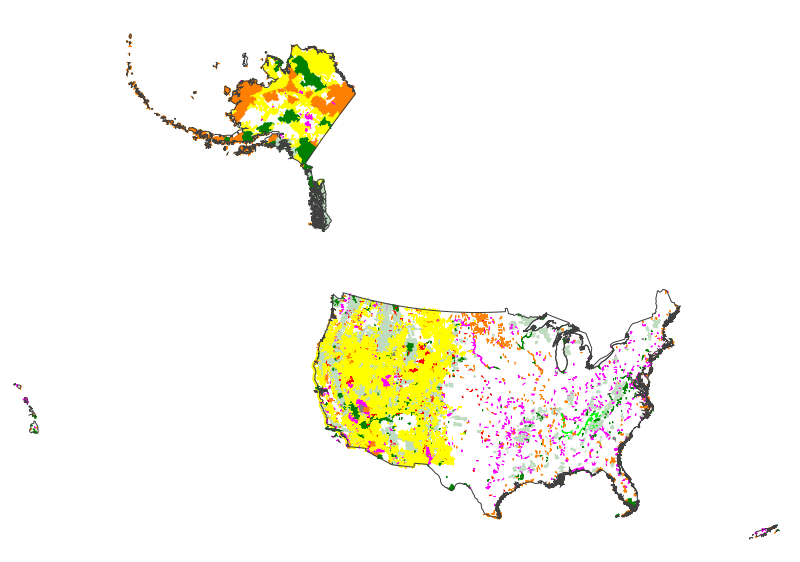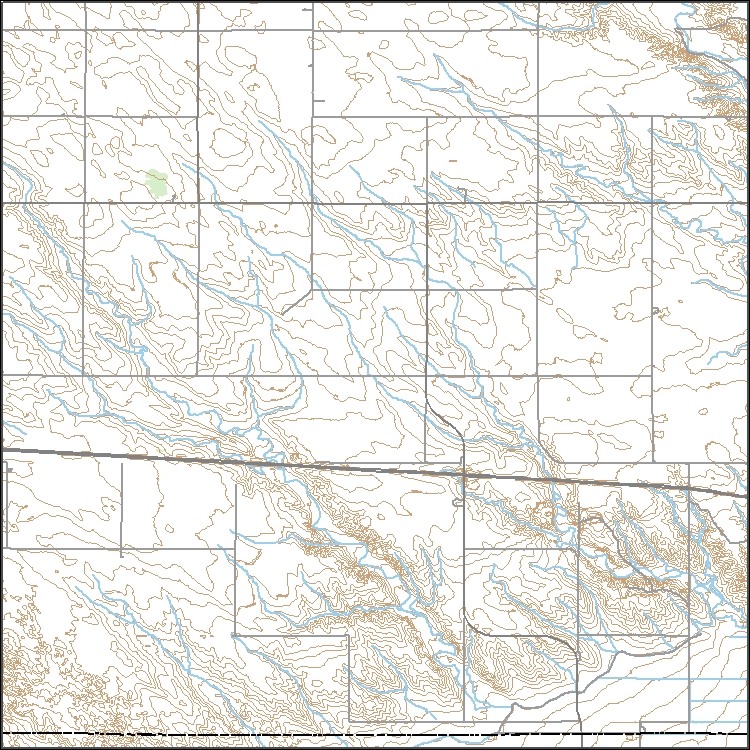Filters: Tags: colorado (X) > partyWithName: U.S. Geological Survey (X)
14,621 results (55ms)|
Filters
Date Range
Extensions Types Contacts
Categories
Tag Types
|
Proportion of low and black sagebrush land cover within a 5-km radius developed using a circular focal moving window analysis.
Categories: Data;
Types: Downloadable,
GeoTIFF,
Map Service,
Raster,
Shapefile;
Tags: Artemisia arbuscula,
Artemisia nova,
Colorado,
Idaho,
Montana,
Location of mixed shrubland land cover obtained from the LANDFIRE Existing Vegetation Type dataset.
Categories: Data;
Types: Downloadable,
GeoTIFF,
Map Service,
Raster;
Tags: Colorado,
Idaho,
Montana,
United States,
Utah,
Development of oil and gas wells leads to the destruction and fragmentation of natural habitat. Oil and gas wells also increase noise levels which has been shown to be detrimental to some wildlife species. Therefore, the density of oil and gas wells in the western United States was modeled based on data obtained from the National Oil and Gas Assessment.
Categories: Data;
Types: Downloadable,
GeoTIFF,
Map Service,
Raster;
Tags: Arizona,
California,
Colorado,
Conservation Assessment,
Idaho,
This data set depicts soil characteristics in western North America. The data set was created from NRCS STATSGO soil data. Calculations were made to reduce one to many relationships to one to one relationships in order to summarize average water capacity, depth to rock, salinity, and pH for each map unit (MUID). ArcMap 8.3 was used to import .dbf files and merge newly created attribute fields to the GIS soil coverage.
This dataset includes the magnetotelluric (MT) sounding data collected in 2006 in the Southern San Luis Valley, Colorado. The U.S. Geological Survey conducted a series of multidisciplinary studies, including MT surveys, in the San Luis Valley to improve understanding of the hydrogeology of the Santa Fe Group and the nature of the sedimentary deposits comprising the principal groundwater aquifers of the Rio Grande rift. The shallow unconfined and the deeper confined Santa Fe Group aquifers in the San Luis Basin are the main sources of municipal water for the region. The population of the San Luis Valley region is growing rapidly and water shortfalls could have serious consequences. Future growth and land management...
Types: Citation;
Tags: Colorado,
Costilla County,
Electromagnetic surveying,
GPS measurement,
Geophysics,
Field spikes were prepared at 207 stream and river sites as part of the U.S. Geological Survey (USGS) National Water Quality Assessment (NAWQA) project between December, 2012, and September, 2015. At the field site, a depth-and width-integrated environmental sample was collected, and one subsample of the environmental sample was spiked with a known amount of a spike mixture. Both the spiked subsample ("spike sample") and another subsample ("environmental sample") of the original water sample were analyzed for pesticides at the USGS National Water Quality Laboratory (NWQL) by direct injection liquid chromatography with tandem mass spectrometry (LC-MS/MS), and were used to calculate the spike recovery of each analyte....
To investigate the effects of imidacloprid on natural stream communities under controlled conditions, experimental streams were dosed with imidacloprid at concentrations ranging from 0.061 to 220 micrograms per liter (µg/L) for a period of 10 days. Natural stream macroinvertebrate communities were obtained from the Cache La Poudre River (Larimer County, CO) by colonizing trays full of large gravel for 75 days. The trays were added to laboratory experimental streams (mesocosms) at the USGS Fort Collins Science Center in Fort Collins, CO. At the end of 10 days, invertebrate abundance metrics were analyzed in relation to measured imidacloprid concentrations in water from the experimental streams. Declines in total...

This map layer consists of federally owned or administered lands of the United States, Puerto Rico, and the U.S. Virgin Islands. For the most part, only areas of 320 acres or more are included; some smaller areas deemed to be important or significant are also included. There may be private inholdings within the boundaries of Federal lands in this map layer. Some established Federal lands which are larger than 320 acres are not included in this map layer, because their boundaries were not available from the owning or administering agency.
A one-year seismic hazard forecast for the Central and Eastern United States, based on induced and natural earthquakes, has been produced by the U.S. Geological Survey. The model assumes that earthquake rates calculated from several different time windows will remain relatively stationary and can be used to forecast earthquake hazard and damage intensity for the year 2016. This assessment is the first step in developing an operational earthquake forecast for the CEUS, and the analysis could be revised with updated seismicity and model parameters. Consensus input models consider alternative earthquake catalog durations, smoothing parameters, maximum magnitudes, and ground motion estimates, and represent uncertainties...
Categories: Data;
Types: Downloadable,
GeoTIFF,
Map Service,
Raster;
Tags: Arizona,
California,
Colorado,
Earthquake,
Hazard,
Density of all roads within a 5-km radius developed using a circular focal moving window analysis.
Categories: Data;
Types: Downloadable,
GeoTIFF,
Map Service,
Raster;
Tags: Colorado,
Idaho,
Montana,
United States,
Utah,
All roads in the western United States from the 2000 US Census Bureau 1:100,000 scale TIGER/line files.
Categories: Data;
Types: Downloadable,
Map Service,
OGC WFS Layer,
OGC WMS Layer,
Shapefile;
Tags: Arizona,
California,
Census 2000,
Colorado,
Idaho,
The USGS Colorado Water Science Center, in cooperation with the Colorado Water Conservation Board, collected hydraulic data for the South Platte River for areas adjacent to Fort Morgan, Colo., based on the USGS streamgage 06759500 South Platte River at Fort Morgan, CO. The hydraulic data include survey point data for 54 cross sections and 10 pressure transducers, which are used to record the river stage beginning at Morgan County Road 16 and extending downstream to Morgan County Road 20.5 near Fort Morgan, Colo. The cross-section and pressure transducer location data were collected using real-time kinematic Global Navigation Satellite Systems by USGS personnel from February 15, 2017, through April 18, 2017. These...
Proportion of all sagebrush species land cover within a 1-km radius developed using a circular focal moving window analysis.
Categories: Data;
Types: Downloadable,
GeoTIFF,
Map Service,
Raster;
Tags: Artemisia spp.,
Colorado,
Idaho,
Montana,
United States,
This dataset “Broad-scale assessment of biophysical features in Colorado: Soil salinity using electrical conductance” presents information extracted from the Natural Resources Conservation Service (NRCS) gridded surface soils geographic database (gSSURGO). Fields retained and presented here include map unit (MU) codes and component (COMP) codes that may be used to reference records in the original, NRCS, data. Soil salinity is typically measured and evaluated based on electrical conductance (EC), and values presented here include the representative value for the map unit component (ECR) and the highest estimated value (ECH). Soils with high salinity can affect the composition of vegetation and can limit production...
Categories: Data;
Types: Downloadable,
GeoTIFF,
Map Service,
Raster;
Tags: Colorado,
geoscientificInformation,
salinity,
soil chemistry,
soil sciences
This dataset consists of the boundary extent used to evaluate regolith thickness, bedrock altitude, depth to water, potentiometric-surface altitude, and saturated thickness for the shallow groundwater system in the Lower Gunnison River Basin, in Delta, Montrose, Ouray, and Gunnison Counties, Colorado. The U.S. Geological Survey prepared this dataset in cooperation with the Colorado Water Conservation Board.
Categories: Data;
Types: Downloadable,
Map Service,
OGC WFS Layer,
OGC WMS Layer,
Shapefile;
Tags: Colorado,
Delta,
Gunnison,
Montrose,
Ouray,
Proportion of salt desert shrub land cover within a 1-km radius developed using a circular focal moving window analysis.
This dataset represents an update to U.S. Geological Survey Data Series 597. Locations and attributes of wind turbines in Colorado, 2009 (available at http://pubs.usgs.gov/ds/597/). This updated Colorado wind turbine Data Series provides geospatial data (fig. 1) for all 1,204 wind turbines established within the State of Colorado as of September 2011, an increase of 297 wind turbines from 2009.Attributes specific to each turbine include: turbine location, manufacturer and model, rotor diameter, hub height, rotor height, potential megawatt output, land ownership, county, and development status of the wind turbine. Wind energy facility data for each turbine include: facility name, facility power capacity, number of...
Categories: Data;
Types: Downloadable,
Map Service,
OGC WFS Layer,
OGC WMS Layer,
Shapefile;
Tags: Colorado,
Energy Development,
Renewable Energy,
USA,
United States,

Layers of geospatial data include contours, boundaries, land cover, hydrography, roads, transportation, geographic names, structures, and other selected map features.
Proportion of juniper land cover within a 18-km radius developed using a circular focal moving window analysis.
Categories: Data;
Types: Downloadable,
GeoTIFF,
Map Service,
Raster,
Shapefile;
Tags: Colorado,
Idaho,
Juniperus,
Montana,
United States,
The vegetation units on this map were determined through a series of image processing steps including unsupervised classification, ecological modeling and stereoscopic interpretation of aerial photographs supported by field sampling and ecological analysis. The vegetation boundaries were identified on the photographs by means of the photographic signature and collateral information on slope, hydrology, geography, and vegetation in accordance with the Standardized National Vegetation Classification System (October 1995). The mapped vegetation reflects conditions that existed during the specific year and season that the aerial photographs were taken. There is a margin of error inherent in the use of aerial photographs....
|

|